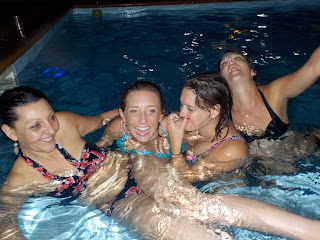Hi Everyone,
I've had a lot of crazy things happen recently (moving to a new place,
dropping my laptop and breaking it, and I've been working hours like crazy). So, to apologize for my absence, I'm going to try to add lots of things to the blog today so that I can share some of the interesting things that I've been seeing here. Here's a small case report that I wrote up for my patient as I followed a very unique presentation:
Case Report:
29/04/2016
Patient presented with history of cervical spine pain and
Guillain-Barre syndrome. But in the last two months he has been having
spasms that he feels in the upper thoracic spine and also in the chest.
He has the feeling as if he may not be able to breathe (but he is able
to keep breathing). Starts in the back, then squeezes at the chest,
and then for some time it proceeds for 2-10 minutes. The first time it
happened he was drinking a glass of water and it occurred when he bent
forward a bit. Patient walks 4-5km per day and it can also happen
during this time. Has stopped doing hard sports for the time being,
used to be a big tennis player.
Physical Exam found upper extremity reflexes to be 2/5 bilaterally
with no sensation loss. Lower extremity reflexes were found at 3-4+/5
bilaterally with no sensation loss bilaterally. S1 reflex on both sides
had one beat of clonus and striking the right patellar reflex was
sometimes able to produce a strong response in the opposite leg.
Cervical ROM was not limited or provocative for any significant pain.
When palpating the upper/mid thoracic spine that patient felt a
sensation of heightened "pressure". Cervical flexion and cervical slump
test reproduced pain in the upper thoracic spine.
At this time an MRI of the Dorsolumbar Spine was ordered in order to
rule out space occupying lesion as a cause of the Upper Motor Neuron
lesion symptoms demonstrated in the lower extremity; no cervical MRI was
ordered due to the lack of upper extremity/cervical symptoms.
05/05/2016
Patient has been worse with walking and sleeping. Cannot sleep on the
left side, as soon as he moves his shoulders together the pain
increases. Forward flexion is very difficult. Sleeping on the back is
the best position. Notices pain in the lower neck. The problem seems to
be related to forward flexion movements now, especially with the neck.
MRI of the Thoracolumbar spine shows no evidence of spinal cord compression or cause of myelopathy.
Physical exam now finds DTR 1/5 right bicep with sensory loss on the
right C6/C7/C8 dermatomes. DTRs are 4/5 bilaterally in the lower
extremity and these reflexes are increased with forward head flexion
and decreased with extension of the neck. C7 spinous is extremely
painful to palpation.
MRI of the Cervical Spine ordered at this time to determine the cause
of the appearance of upper extremity Lower Motor Neuron lesion signs.
09/05/2016
Patient returned with the results of the Cervical MRI. Has found that
extending his neck during his episodes of spasm reduces the duration of
them and he has had less spasms since he has started performing this
movement. Patient admits to chronically "cracking" his own neck for the
past few years.
MRI of the Cervical Spine finds osteo discal bars at the C3/4, C4/5, and C5/6 levels which are irritating the thecal sac.
Physical exam finds DTR 1/5 right bicep, sensation loss C6/C7 on the
right, and DTR lower extremity 4+/5 that is reduced to 2/5 after 10x3
seated extension+retraction movements of the neck.
Due to the signs diminishing with movements in the extension and
retraction motions, end of the table distraction coupled with extension
and chin retraction was performed in three sets of ten. During this the
patient had some discomfort at the cervicothoracic junction but
afterwards there was no pain. Patient was instructed on how to perform
seated extension and retraction exercises in order to monitor his
symptoms and to call if there was any significant change.
At this point the diagnosis of Cervical Spondylosis with
Myelopathy/Myelopathic signs was made. It is possible that the
patient's chronic self-manipulation of the cervical spine
could have contributed to the problem by creating an instability in the
cervical spinal ligaments. This instability coupled with the osteo
discal bars irritating the anterior thecal sac seem to be the cause of
the motor neuron lesion signs that appeared during the examinations. It is also to remember this patient's history of neurologic disease. The
patient is set to review again at the week's end on
whether the symptoms change with the correctional exercise prescribed
today. Patient was informed that if the symptoms do not reduce with
corrective exercise that a surgical consultation may be necessary.
13/05/2016
After last treatment patient felt okay for two days, then Wednesday
was very sore and had some trouble. On Thursday he had no trouble at
all even with lots of driving, moving, etc (only a bit of tension at
the CT junction). Today he had some trouble in the morning but from
9:00am to 1:30pm there has been no issue. Consulted with the
neurosurgeon and the neurosurgeon did not feel that the case was a
surgical one. Patient is now able to sleep on his side. When he wakes
up is when the pain is most important, but as soon as he returns to
laying on his back the symptoms are relieved.
DTR 1/5 right bicep, sensation loss C6/C7 that recovers after
allowing the head to stay in extension for about 30 seconds. DTR lower
extremity 4/5 right more so than left that recovers to 2/5 after
extension movement.
Advised the patient to continue with the extension movement as it
both shows promise for his symptoms in the physical exam and he feels
relief when performing this action. Patient recommended to seek
consultation with neurologist at this time to comanage the case.































